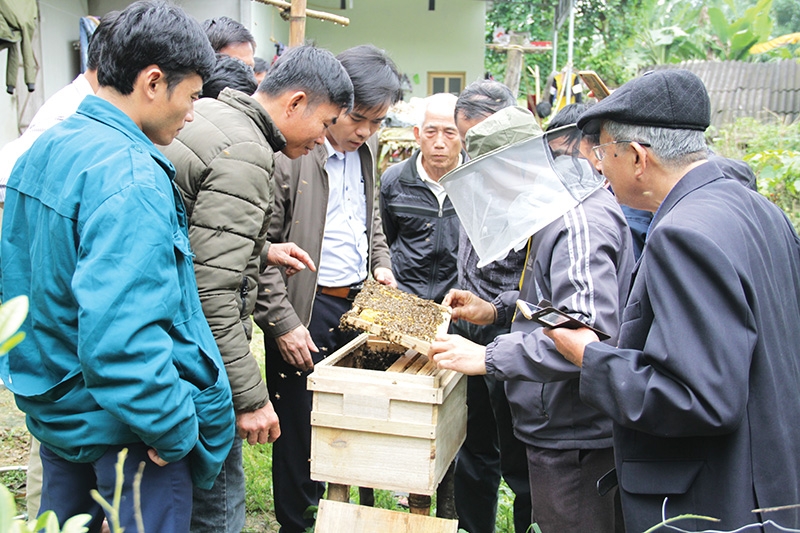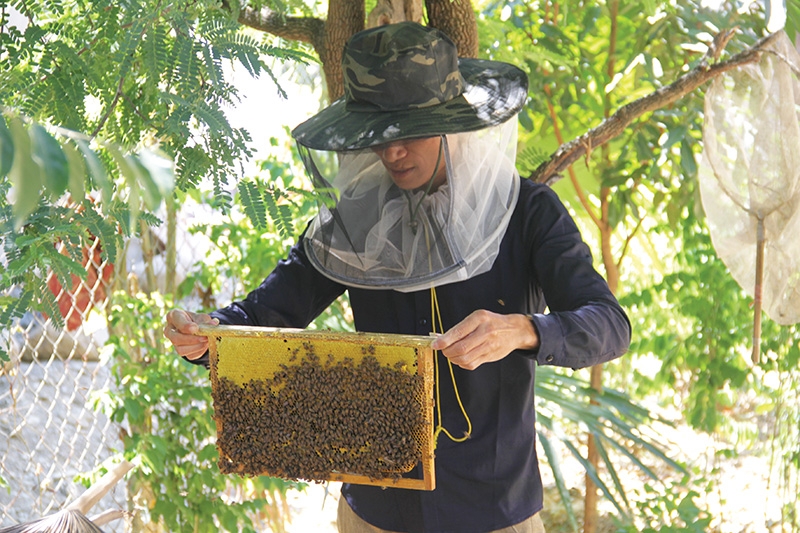Beekeepers buzzing with initiative’s enhancements
 |
| The GCF beekeeping component is assisting with training as well as higher-quality honey |
The six-member family of Vu Tan Suu has been engaging in keeping honey bees for a few years, with just enough income to make ends meet. Each bee colony could produce only 2-3kg of honey, with low quality.
“We could earn about VND100,000-200,000 ($4.35-8.70) per kg, while input costs were high, so profits were meagre,” Suu told VIR. “It was because we did the trade based on experience shared by neighbours and friends.”
Suu, 68, lives in Da Loc commune in Hau Loc district of Thanh Hoa – where residents are largely living on agricultural and fishery activities, with a low average per capita income of about VND20 million ($870) a year.
However, last February, Suu’s family was provided five colonies of breeding honey bees for free, along with feed within the first two months of raising, through a component backed by the Green Climate Fund (GCF). This component is part of a wider project to improve the resilience of coastal communities to climate change in Vietnam, funded jointly by the GCF, the Vietnamese government, and the United Nations Development Programme.
The scheme has also provided beneficiaries with professional technical training including modern techniques in keeping bees, improving honey quality without using chemicals, and enabling beekeepers to increase their product sales.
The component in Thanh Hoa was implemented from late 2019 and over the first six months of 2020 benefited 54 households, with 40 in Da Loc commune and 14 in Nga Thuy commune of Nga Son district.
Previously, the amount of such honey breeds was put out to tender by the GCF Project Management Unit of Thanh Hoa to select a reputable contractor with experience in high quality breeding. Cam Thuy Honey Bee One Member Co., Ltd. won the bidding. Through inspection, the quantity and quality are met, ensuring the conditions for rearing.
“From the first five colonies given by the component, we have been able to develop the number of colonies to 11 so far,” Suu said. “The quality of honey has improved significantly. Each colony can produce 7-9kg of honey, and we can earn as much as VND200,000-300,000 ($8.70-13) per kg. Our life has gradually been changing.”
 |
Stronger means of subsistence
In Da Loc, there is a mangrove forest with high-quality blossoms for bees to seek feed. Among the 40 households benefiting from the GCF component, 11 are headed by women. Under the component, all of the beneficiary households are carefully selected by localities’ panels, and they are all poor and vulnerable to natural disasters and climate change.
These 40 households, including Suu’s, were provided with a total 84 colonies of breeding honey bees last February. However, in just seven months the number of the colonies increased to 420.
Before the GCF component was implemented in Da Loc, each household raked in an average of 3kg of honey per colony, with total sales revenue of VND600,000 ($26), and profit of VND400,000 ($17). However, thanks to the component, the volume of honey has increased to 7kg per colony, with total sale revenue of VND1.4 million ($60) or VND200,000 ($8.70) per kg.
Along with Da Loc, the 14 households benefiting from the GCF component in Nga Thuy commune of Nga Son district – where there is also a mangrove forest – have also seen their livelihoods improved thanks to the honey bees. These households have established a beekeeping cooperative – members cooperate with one another voluntarily, with the motto of mutual help for shared development. They frequently exchange ideas, techniques, and experiences, materials, and breeds.
Nguyen Van Tai, 67, is one such member. Previously he only did the empirical trade shared by other households who also raised the animal with experiences handed down from unprofessional farmers. However, the income of Tai’s family has multiplied since last January when he, like Suu’s family in Da Loc, was provided free-of-charge breeding honey bees, feed within the first two months, and technical training.
“From the first five colonies given by the component, we have been able to develop the number to 30 so far,” Tai told VIR. “Keeping honey bees has brought about good income for locals. With experience learned from the GCF’s component, all the 14 household beneficiaries have been able to expand trade.”
Like Tai’s family, Dao Trong Cu, 61, has raised honey bees for many years. Currently his family keeps 34 colonies, including five provided by the GCF initiative. “This beekeeping model has been warmly welcomed in the commune as locals see long-term potential from it, which can produce high profits and ensure environmental sustainability,” Cu said. “Our family’s income has also increased significantly, while investment costs have decreased.”
“Also thanks to the training and technical support, beekeepers have limited the loss of herds, and farmers have self-developed the herds,” he added.
According to a report on the component results by the GCF Project Management Unit of Thanh Hoa, the volume of honey reached 8-10kg per colony per year, with products ensuring high standards for sales in the market.
In Thanh Hoa, mangrove forest-based bees produced in Da Loc and Nga Thuy communes are much known by customers though it has yet to develop its own brand name. These communes face the sea, with mangrove forests where bees can seek feed. Mangrove forest-based bee honey is said by experts to have better quality than that produced by bees living in other locations, as the mangrove blossoms are free from chemicals and pesticides.
Need of expansion
Vu Tan Suu from Da Loc commune told VIR, “In my locality, about 200-300 poor households are in need of such support. They also want to raise bees to increase their income.”
Nguyen Van Tai from Nga Thuy commune also sees a big future for his family thanks to the bees. “Hundreds of other families in the commune also wish to be supported by the GCF scheme after seeing how it can increase incomes and provide new knowledge of beekeeping. Besides, they also want to create a veritable brand name for bee honey in Nga Thuy.”
According to the GCF Project Management Unit of Thanh Hoa, it is suggested that the beekeeping model can be expanded to more farmer households in the province on a larger scale. This will help residents improve their awareness of protecting the mangrove forests, which are aimed to shield villages from disasters and provide a good habitat for bees to seek feed, then help locals improve their livelihoods.
Previously, the majority of beekeepers lacked experience and technique in beekeeping for honey. In addition, beekeepers have no links, sharing, or support to develop bee colonies, so bees often fly by themselves and lose their groupings, while producers have achieved low honey outputs.
Over the past few years, in addition to implementing the honey bee raising model in Da Loc and Nga Thuy, Thanh Hoa’s management unit has also been implementing another six livelihood models adapted to climate change in the coastal districts of the province, with more than 140 beneficiary households.
Such models include raising duck mea in Da Loc commune; raising broiler chickens to ensure biosafety in Hung Loc commune in Hau Loc district; raising black tiger shrimp intercropped with green crabs in Nga Thuy commune; black tiger shrimp farming intercropped with tilapia; commercial green crab farming; and beekeeping for honey in Nga Tan commune of Nga Son district.
Most of the models are highly appreciated, suitable for localities, and capable of coping well with epidemics and unusual changes of weather.
What the stars mean:
★ Poor ★ ★ Promising ★★★ Good ★★★★ Very good ★★★★★ Exceptional
Themes: Climate Change Response
Related Contents
Latest News
More News
- Protect what’s next: towards a future free from meningococcal group B disease (December 05, 2025 | 18:00)
- New ILO report offers policy recommendations for disability inclusion (December 04, 2025 | 15:18)
- Maternal job loss may affect children’s mental health, research shows (December 03, 2025 | 19:11)
- Women lead Vietnam’s shift to climate-resilient agriculture (December 03, 2025 | 19:10)
- Experts highlight unpaid care work as key barrier to gender equality (December 03, 2025 | 15:15)
- Opportunities and inequalities for women workers in Vietnam's garment industry (December 03, 2025 | 09:00)
- Vietjet flights carry love to devastated central region (November 28, 2025 | 11:35)
- New initiative to boost the fight against domestic violence (November 26, 2025 | 10:00)
- South Korea funds IOM relief for Vietnam’s typhoon-affected communities (November 24, 2025 | 15:33)
- AI and human-centred values set to shape the future of HR in Vietnam (November 21, 2025 | 18:04)

 Tag:
Tag:





















 Mobile Version
Mobile Version